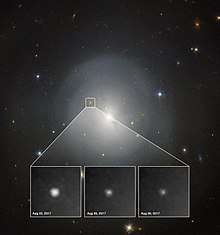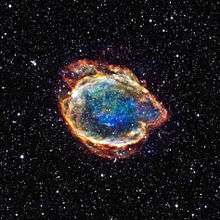Kilonova
A kilonova (also called a macronova or r-process supernova) is a transient astronomical event that occurs in a compact binary system when two neutron stars or a neutron star and a black hole merge into each other. Kilonovae are thought to emit short gamma-ray bursts and strong electromagnetic radiation due to the radioactive decay of heavy r-process nuclei that are produced and ejected fairly isotropically during the merger process.[1]

History
The term kilonova was introduced by Metzger et al. in 2010[2] to characterize the peak brightness, which they showed reaches 1000 times that of a classical nova. They are 1⁄10 to 1⁄100 the brightness of a typical supernova, the self-detonation of a massive star.[3]
The first kilonova to be found was detected as a short gamma-ray burst, SGRB 130603B, by instruments on board the Swift Gamma-Ray Burst Explorer and KONUS/WIND spacecrafts and then observed using the Hubble Space Telescope 9 and 30 days after burst.[1]
In October 2018, astronomers reported that GRB 150101B, a gamma-ray burst event detected in 2015, may be analogous to the historic GW170817, a gravitational wave event detected in 2017, and associated with the merger of two neutron stars. The similarities between the two events, in terms of gamma ray, optical and x-ray emissions, as well as to the nature of the associated host galaxies, are considered "striking", and this remarkable resemblance suggests the two separate and independent events may both be the result of the merger of neutron stars, and both may be a hitherto-unknown class of kilonova transients. Kilonova events, therefore, may be more diverse and common in the universe than previously understood, according to the researchers.[4][5][6][7]
Theory
The inspiral and merging of two compact objects are a strong source of gravitational waves (GW).[2] Kilonovae are thought to be progenitors of short gamma-ray bursts[2] (GRB) and the predominant source of stable r-process elements in the Universe.[1] The basic model for neutron star mergers was introduced by Li-Xin Li and Bohdan Paczyński in 1998.[8]
Observations

The first observational suggestion of a kilonova came in 2008 following the short-hard gamma-ray burst GRB 080503,[10] where a faint object appeared in optical and infrared light after one day and rapidly faded. Another kilonova was suggested in 2013, in association with the short-duration gamma-ray burst GRB 130603B, where the faint infrared emission from the distant kilonova was detected using the Hubble Space Telescope.[1]
On October 16, 2017, the LIGO and Virgo collaborations announced the first simultaneous detections of gravitational waves (GW170817) and electromagnetic radiation (GRB 170817A, SSS17a) of any phenomena,[11] and demonstrated that the source was a kilonova caused by a binary neutron star merger.[12] This short GRB was followed by a longer transient visible for weeks in the optical electromagnetic spectrum (AT 2017gfo) located in a relatively nearby galaxy, NGC 4993.[13]
See also
References
- Tanvir, N. R.; Levan, A. J.; Fruchter, A. S.; Hjorth, J.; Hounsell, R. A.; Wiersema, K.; Tunnicliffe, R. L. (2013). "A 'kilonova' associated with the short-duration γ-ray burst GRB 130603B". Nature. 500 (7464): 547–549. arXiv:1306.4971. Bibcode:2013Natur.500..547T. doi:10.1038/nature12505. PMID 23912055.
- Metzger, B. D.; Martínez-Pinedo, G.; Darbha, S.; Quataert, E.; Arcones, A.; Kasen, D.; Thomas, R.; Nugent, P.; Panov, I. V.; Zinner, N. T. (August 2010). "Electromagnetic counterparts of compact object mergers powered by the radioactive decay of r-process nuclei". Monthly Notices of the Royal Astronomical Society. 406 (4): 2650. arXiv:1001.5029. Bibcode:2010MNRAS.406.2650M. doi:10.1111/j.1365-2966.2010.16864.x.
- "Hubble captures infrared glow of a kilonova blast". spacetelescope.org. 5 August 2013. Retrieved 28 February 2018.
- University of Maryland (16 October 2018). "All in the family: Kin of gravitational wave source discovered - New observations suggest that kilonovae -- immense cosmic explosions that produce silver, gold and platinum--may be more common than thought". EurekAlert!. Retrieved 17 October 2018.
- Troja, E.; et al. (16 October 2018). "A luminous blue kilonova and an off-axis jet from a compact binary merger at z = 0.1341". Nature Communications. 9 (1): 4089. arXiv:1806.10624. Bibcode:2018NatCo...9.4089T. doi:10.1038/s41467-018-06558-7. PMC 6191439. PMID 30327476.
- Mohon, Lee (16 October 2018). "GRB 150101B: A Distant Cousin to GW170817". NASA. Retrieved 17 October 2018.
- Wall, Mike (17 October 2018). "Powerful Cosmic Flash Is Likely Another Neutron-Star Merger". Space.com. Retrieved 17 October 2018.
- Li, L.-X.; Paczyński, B.; Fruchter, A. S.; Hjorth, J.; Hounsell, R. A.; Wiersema, K.; Tunnicliffe, R. (1998). "Transient Events from Neutron Star Mergers". The Astrophysical Journal. 507 (1): L59–L62. arXiv:astro-ph/9807272. Bibcode:1998ApJ...507L..59L. doi:10.1086/311680.
- "Hubble observes source of gravitational waves for the first time". www.spacetelescope.org. Retrieved 18 October 2017.
- Perley, D. A.; Metzger, B. D.; Granot, J.; Butler, N. R.; Sakamoto, T.; Ramirez-Ruiz, E.; Levan, A. J.; Bloom, J. S.; Miller, A. A. (2009). "GRB 080503: Implications of a Naked Short Gamma-Ray Burst Dominated by Extended Emission". The Astrophysical Journal. 696 (2): 1871–1885. arXiv:0811.1044. Bibcode:2009ApJ...696.1871P. doi:10.1088/0004-637X/696/2/1871.
- Abbott, B. P.; Abbott, R.; Abbott, T. D.; Acernese, F.; Ackley, K.; Adams, C.; Adams, T.; Addesso, P.; Adhikari, R. X.; Adya, V. B.; et al. (LIGO Scientific Collaboration & Virgo Collaboration) (16 October 2017). "GW170817: Observation of Gravitational Waves from a Binary Neutron Star Inspiral". Physical Review Letters. 119 (16): 161101. arXiv:1710.05832. Bibcode:2017PhRvL.119p1101A. doi:10.1103/PhysRevLett.119.161101. PMID 29099225.
- Miller, M. Coleman (16 October 2017). "Gravitational waves: A golden binary". Nature. News and Views (7678): 36. Bibcode:2017Natur.551...36M. doi:10.1038/nature24153.
- Berger, E. (16 October 2017). "Focus on the Electromagnetic Counterpart of the Neutron Star Binary Merger GW170817". Astrophysical Journal Letters. Retrieved 16 October 2017.

